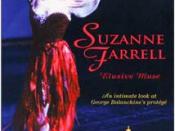Suzanne Farrell
Suzanne Farrell is a legendary ballerina figure , and is considered one of the most influential ballet dancers of the 20th century . She was b orn with the name Roberta Sue Ficker in 1945 in Cincinnati , Ohio , where she started dancing at the age of eight, and spent her childhood studying at the Cincinnati Conservatory of Music . Her parents divorced when she was 10, and she lived with her mother , grandmother, and two older sisters. In 1959 , Farrell won a scholarship and was chosen to study at the School of American Ballet in New York , founded by the world famous choreographer named George Balanchine , and it is the official academy of the New York City Ballet . Suzanne Farrell attended the school in 1960 , and by 1961 she was performing with the New York City Ballet , by which time she had adopted her professional name , Suzanne Farrell. She made her first New York appearance in a minor role in the New York City Ballet ' s annual Christmas production of The Nutcracker in 1960 . She was an exceptional dancer and quickly became Balanchine's star ballerina . In 1962 she made her first appearance in a featured role in Serenade . By 1963 , roles were being created for her . Her first solo performance was in the premiere of John Taras's Arcade in 1963 . That same year she created the lead role in George Balanchine 's Movements for Piano and Orchestra . Two years later Balanchine created for her the role of Dulcinea in Don Quixote ; the 1965 performance made her a star , and that same year she was promoted to principal dancer. In 1969, Farrell got married to Paul Mejia and left Balanchine and the New York City Ballet , t o spend a couple of years dancing and traveling throughout Europe . By 1975 , Suzanne Farrell returned to the New York City Ballet where she remained , working with Balanchine until his death in 1983 . More than 2000 performances did Farrell do with Balanchine's company , including world tours, appearances on TV, and movies. In 1983 she developed arthritis, and became a tremendous physical toll on her body . Farrell tried treatment for two years, but kept struggling so she retired from performing in 1989 .
Farrell achieved a career like no other precedent of history of ballet . She danced as a professional ballerina for 28 years on stage, and danced a repeater of more than 100 ballets . Now 68 , she has dedicated this phase of her life to presenting the works of her mentor, Balanchine, who died in 1983. She has staged many of Balanchine's works for such companies as: Berlin Opera Ballet , Vienna State Opera, Royal Danish Ballet, The Paris Opera Ballet, Kirov Ballet , Bolshoi Ballet, and many other companies located in Boston, Miami, Seattle, Cincinnati , Forth Worth, and New York. In 2001 , Farrell started her own company called The Suzanne Farrell Ballet , where they perform annually at the Kennedy Center. Farrell teaches at a full-time job as a professor in the dance department at Florida State University in Tallahassee , Fl . She appears in many movies throughout her career such as: A Midsummer Night's Dream (1967) , Dancing for Mr. B: Six Balanchine Ballerinas (1989) , Suzanne Farrell: Elusive Muse (1996), Choreography by Balanchine: Tzigane, Andante form, Temperaments , Selections form Jewels (2004), and Jerome Robbins: Something to Dance About (2009) . She also published her autobiography book in 1990 called Holding on to the Air . Suzanne Farrell has had a very successful career, and has achieved great excellence, where she has won many artistic and academic awards , the highlights of which are the 2003 National Medal of the Arts and the 2005 Capezio Award .


